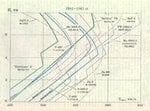Sticking bits and pieces on the outside increases the drag. Same problem as as Bell's attempt's at an external turbo add on.
Not quite as Bell's add on turbo; my idea puts far less parts at the plane's exterior.
You may get your 380-400mph at 20-25,000ft in 1941-43 but if you cut the sea level speed from about 310mph to 270-280mph and the speed at 10,000ft from 350mph to 310-320mph you wind up with a very specialized airplane.
Now why the P-39 with 1325 HP will do only 320 mph @ 10K? P-63 was capable of 350 @ 10K with 1300 HP, despite having 10 % more of equivalent flat plate area (P-39 was making 360 there, with 1100 HP). The 'notorius' Bf-109G-2 was loosing 12-13 mph with wing cannons installed; no increase in power there.
So even if we take external plumbing into account, saying that it would've cut 50 mph, while providing 200 HP more, is highly questionable.
It will also climb worse than a standard P-39 up to about 15,000ft or so. Pulling the wing guns may not be enough (especially if you stick in extra fuel).
Seeing that P-39 climbed better than most (all?) SE fighters made in USA (apart from P-63), I'd say that turbo P-39 wouldn't be at any disadvantage. Regular 39 out-climbed the Spit Vs, IIRC.
We could also mention that, at higher altitude, the advantage would've been even greater (not vs. paddle blade P-47s?). Sure enough, if a commander wants his planes to intercept something, those planes wouldn't be carrying the drop tanks, but have only internal 160 gals.
It is only when the 1425 hp engine becomes available that this starts to look attractive and by then the need for it is fading.
If the low-production models are made (1150 HP), followed with mass produced 1325 HP model (early 1942-mid '43), then such a plane plays far more important role than regular P-39 or P-40. It's also more easily available than P-38. RAF/RAAF are also satisfied costumers. A next step (1425 HP in mid 1943; meaning we have 1600 HP @ WER) is as much expected as P-38H was, but here we talk about all theaters, not just PTO.
Of course, by 1944 a slight redesign of front hull is needed (HMGs staggered, so their ammo boxes can be enlarged to hold 300 rds, 37mm replaced by belt fed Hispano - sorry, P-38). 4-bladed prop. Instead of 2 x 75 gals, it's 2 x 108 in drop tanks.
You do need bigger radiators and oil coolers for the higher powered engines and even the intercooler needs to change from the early version to the late version. The diagrams and pictures were to give you an idea of the size of the pipes/ducts you are dealing with. You can shorten them and change them form square to round or vis versa but you can't make them smaller in cross section (especially forhe higher HP engines)
Same things were true for all planes experiencing increase in engine power, so I see no issues here.

